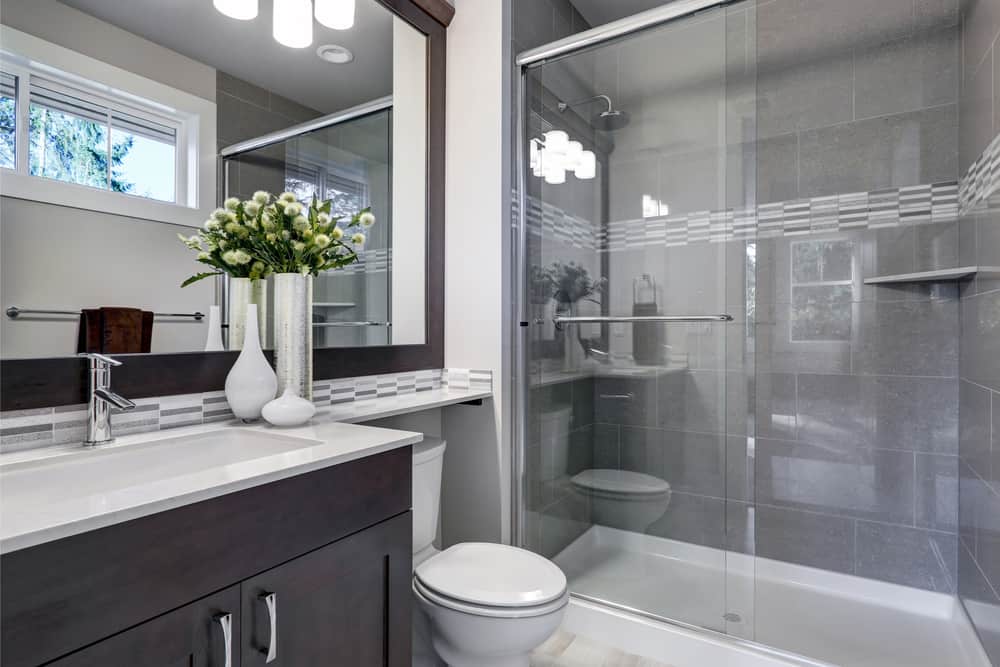Summary:
How Nassau County's Climate Affects Exterior Paint Lifespan
With proper preparation and quality materials, exterior paint should last 5-7 years on South Shore properties and 6-8 years in less exposed North Shore areas. But here’s what makes Nassau County different from inland areas: your paint isn’t just dealing with normal weather.
Nassau County’s 75% average humidity and 40-degree temperature swings require specialized preparation techniques that prevent moisture damage and thermal expansion problems. This means your exterior paint expands and contracts constantly, creating stress points that lead to cracking and peeling if the wrong materials or techniques are used.
The coastal location adds another layer of complexity. If your exterior paint isn’t protected, saltwater can cause chipping, peeling, and fading. Saltwater damage is a year-round issue. Even homes several miles inland deal with salt-laden air that gradually breaks down paint bonds and accelerates deterioration.
Why Coastal Homes Need Different Painting Schedules
Coastal homes exposed to salty air and strong winds might require more frequent repainting (every 4-5 years). This isn’t just marketing from painting contractors—it’s the reality of living near the water.
Moisture builds up much more near the coast. The higher the humidity, the more moisture is in the air. High levels of moisture can lead to mold, which can start eating away at the exterior paint. When mold and mildew get established, they don’t just sit on the surface. They actually feed on the paint’s binding agents, creating weak spots that lead to widespread failure.
In addition to the humidity, the sun has harsh UV rays that beat down on the exterior of your home. Extended exposure will end up fading the paint color. Sun exposure and humidity can also create a soap-like film on the paint over time. This combination of moisture and UV damage creates a one-two punch that standard paint formulations simply can’t handle long-term.
The salt factor makes everything worse. Salt is constantly attacking seaside homes, too. Fierce winds whip up ocean whitecaps and send spray through the air and right up against the house. Once the spray dries, it leaves a thin coat of salt on the wood. Our experience is that any coating applied over salt won’t adhere very well or for very long.
This is why South Shore properties typically need attention every 5-7 years, while North Shore homes might stretch to 6-8 years. The difference isn’t just distance from water—it’s exposure to prevailing winds, salt concentration, and the specific microclimate around your property.
Signs Your Nassau County Home Needs Repainting Soon
Don’t wait for obvious peeling to start planning your next exterior painting project. Fading or chalking is another very common problem. Sunny days blast your home with UV rays, which break down the resin in the paint. Resin is the primary component in paint that protects the home. When the house starts to fade, this is an indication that the resin has broken down in the paint and there is minimal protection on your home.
Here’s what to watch for during your annual home inspection: Chalky residue when you run your hand along the siding means the paint’s protective qualities are failing. This usually happens 1-2 years before visible peeling starts, giving you time to plan properly.
It’s very common for areas on the trim to begin peeling. Most trim that’s peeling is real wood, such as 1×2’s used on the fascia, door trim, garage trim, or railings. Any areas where moisture accumulates can also start to peel. These areas take a lot of damage from moisture sitting on them and freezing then thawing while constantly beating on the paint. Once the paint begins to peel, those areas on your home are exposed.
Pay special attention to the north side of your home. After 7-10 years, many times the underside of the siding will start to peel, specifically on the North side of the home. The North side of the home experiences less sunshine, so moisture is more likely to stick around longer. This moisture slowly wears away the paint on the underside of the siding boards. Each time it rains or snows, more moisture runs down the side of the house, wearing down the paint.
Caulk failure is another early warning sign. Builders use inexpensive and low-quality caulking when building and painting your house. As the temperatures change, your house expands and contracts. As this happens over and over again, the caulking doesn’t hold up and begins to break down and crack, leaving your home exposed. Moisture can get into these cracks and can then go back behind your boards.
Best Timing for Exterior Painting in Nassau County
Late spring (May-June) and early fall (September-October) typically offer the most favorable conditions with moderate temperatures and humidity. Summer painting is possible but requires careful scheduling around humidity spikes.
The key is understanding that Nassau County’s painting season is shorter and more specific than inland areas. Early summer and early fall usually offer up the best weather conditions, with minimal rain and minimal fluctuations in temperature from day to night. This will ensure the paint goes on smoothly and has the chance to dry and cure properly.
Temperature matters more than most homeowners realize. It should be at least 50° F when you’re applying the paint and shouldn’t drop below 32° F at night for several days after. Even if it’s warm during the day, the paint won’t form a good film if temperatures drop too low at night. Paint needs several days to cure, and as the temperature dips, dew can form on surfaces and cause the water in the paint to evaporate too slowly. That affects how the paint holds up over time, including how well it resists cracking.
Why Weather Windows Matter More in Coastal Areas
A perfect day for exterior painting is generally when the humidity levels are between 40% – 50% relative humidity. If the humidity level is above 85%, it’s best to cut your losses and wait for a better day to paint. However, if the humidity level outside is between 50% – 85%, you can still achieve great results as long as you follow expert tips for painting outdoors in high humidity.
The challenge in Nassau County is that humidity levels regularly exceed these ideal ranges, especially during summer months. Long Island summers bring more than beach days and backyard barbecues—they bring humidity levels exceeding 80%. This persistent moisture creates perfect conditions for paint failures, particularly in older homes with existing moisture issues. High humidity affects paint in several critical ways: Extends drying time between coats, often leading to improper curing · Promotes mold and mildew growth beneath paint surfaces · Causes expansion in wood substrates, stressing paint bonds
Professional painters work around these conditions by starting early and timing their work carefully. When you’re painting outdoors, it’s crucial to begin during the early hours of the morning when humidity levels are higher. This might sound counterintuitive, but we do this because as you approach midday, the temperatures rise and the humidity falls. If you time this right, your coats of paint will begin to dry during the time of day when the relative humidity is not as intense, giving you a much better shot at success. Once you pass the midday point and get into the late afternoon, the humidity levels rise again and you risk running into issues if you continue to paint.
This is why professional exterior painting projects in Nassau County often take longer than inland jobs—contractors need to work within these narrow weather windows to ensure proper curing and adhesion.
How to Extend Your Paint Job's Lifespan
The difference between a 3-year paint job and a 10-year paint job often comes down to preparation and material selection. Proper surface preparation by house painters in Nassau County prevents 90% of paint failures that cost homeowners $2,000-4,000 in repairs. Professional techniques extend paint life from 4-5 years to 10-12 years.
Proper surface preparation adds $1.50-2.50 per square foot to project costs but extends paint life from 5 years to 12 years, reducing your annual cost per square foot by 60%. Painting contractor services that skip preparation steps initially cost 20-30% less but require complete repainting within 3-4 years when adhesion failures develop. Nassau County homeowners who invest in professional preparation avoid $3,000-5,000 in premature repainting costs and maintain property values that depend on exterior appearance and condition.
Material selection makes an enormous difference in coastal environments. We select exterior coatings with UV inhibitors that prevent color fading for 12-15 years in Nassau County’s intense sunlight, rather than the 3-5 years typical of consumer-grade paints. These specialized formulations cost more upfront but deliver significantly better value over time.
Acrylic latex paint is one of the best options for homes in humid or coastal regions. Here’s why: Water Resistance: It forms a durable, water-resistant coating that prevents moisture infiltration. Breathability: Acrylic latex paint allows trapped moisture to escape, reducing the risk of blistering. UV Protection: Many high-quality acrylic paints are formulated to resist fading from sunlight exposure.
Regular maintenance extends any paint job’s life. Even the best paints require regular upkeep in coastal or humid environments. Wash painted surfaces regularly to remove salt and grime, and inspect for signs of wear or damage. An annual power washing and inspection can add 1-2 years to your paint job’s lifespan by preventing small problems from becoming major failures.
Making Smart Exterior Painting Decisions in Nassau County
Your Nassau County home’s exterior paint timeline isn’t just about following a schedule—it’s about understanding how your specific location, exposure, and material choices work together to determine when repainting makes sense. South Shore properties typically need attention every 5-7 years, while North Shore homes might stretch to 6-8 years, but these timelines depend heavily on preparation quality and material selection.
The key insight is that investing in proper preparation and premium materials designed for coastal conditions costs more upfront but delivers significantly better long-term value. When you consider that proper preparation can extend paint life from 5 years to 12 years while preventing thousands in premature repainting costs, the math becomes clear.
Don’t wait for obvious failure signs to start planning your next exterior painting project. Watch for chalking, caulk deterioration, and early peeling—especially on trim and north-facing surfaces—to time your project optimally. When you’re ready to protect your investment with professional exterior painting that’s designed to handle Nassau County’s challenging coastal climate, we combine local expertise with premium materials and proven preparation techniques that deliver lasting results.




